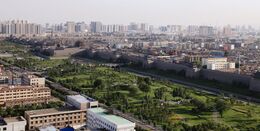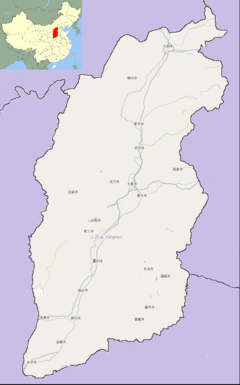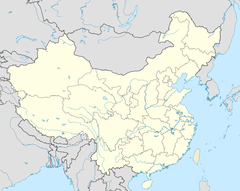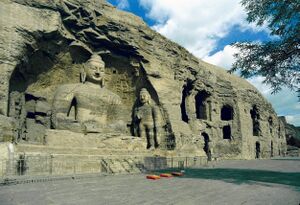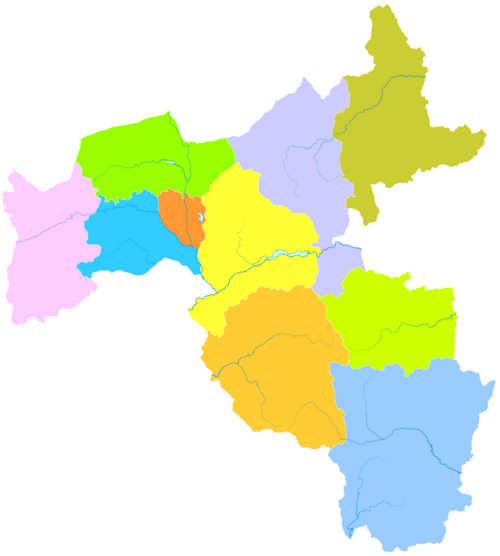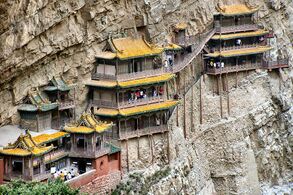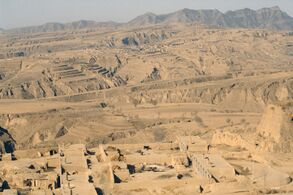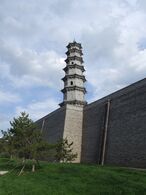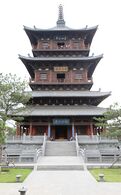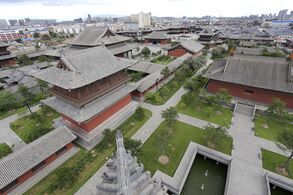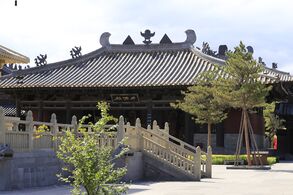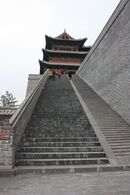داتونگ
داتونگ
大同市 Datong, Tatung | |
|---|---|
|
From top down, left to right: Datong panorama; Shanhua Temple; Huayan Temple; Yungang Grottoes; Tower at Lingyan Temple; Temple of Confucius (Wenmiao); Guandi Temple; Yinghui Gate of the City Wall | |
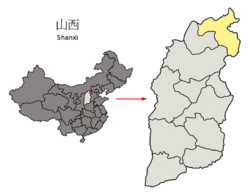 Location of Datong City jurisdiction in Shanxi | |
| الإحداثيات (Datong municipal government): 40°05′49″N 113°22′01″E / 40.097°N 113.367°E | |
| البلد | جمهورية الصين الشعبية |
| المقاطعة | شانشي |
| مقر البلدية | مديرية پينگتشنگ |
| الحكومة | |
| • النوع | مدينة بمستوى محافظة |
| • أمين الحزب | Zhang Jifu |
| المساحة | |
| • مدينة بمستوى محافظة | 14٬068 كم² (5٬432 ميل²) |
| • الحضر | 3٬563 كم² (1٬376 ميل²) |
| • العمران | 976 كم² (377 ميل²) |
| المنسوب | 1٬042 m (3٬419 ft) |
| التعداد (2020 census)[2] | |
| • مدينة بمستوى محافظة | 3٬105٬591 |
| • الكثافة | 220/km2 (570/sq mi) |
| • Urban | 2٬030٬203 |
| • الكثافة الحضرية | 570/km2 (1٬500/sq mi) |
| • العمرانية | 1٬790٬452 |
| • الكثافة العمرانية | 1٬800/km2 (4٬800/sq mi) |
| منطقة التوقيت | UTC+8 (China Standard) |
| Postal code | 037000 |
| مفتاح الهاتف | 0352 |
| ISO 3166 code | CN-SX-02 |
| License Plates | 晋B |
| Administrative division code | 140200 |
| الموقع الإلكتروني | dt |
| داتونگ | |||||||||
|---|---|---|---|---|---|---|---|---|---|
| الصينية | 大同 | ||||||||
| المعنى الحرفي | الوحدة العظمى التجمع الأعظم | ||||||||
| |||||||||
| أسماء سابقة | |||||||||
|---|---|---|---|---|---|---|---|---|---|
| Pingcheng | |||||||||
| الصينية التقليدية | 平城縣 | ||||||||
| الحروف المبسطة | 平城县 | ||||||||
| المعنى الحرفي | المدينة المسالمة County ناحية المدينة المهدأة | ||||||||
| |||||||||
| Xijing | |||||||||
| الصينية | 西京 | ||||||||
| المعنى الحرفي | Western Capital | ||||||||
| |||||||||
داتونگ Datong هي مدينة بمستوى محافظة في شمال مقاطعة شانشي في جمهورية الصين الشعبية. وتقع في حوض داتونگ على ارتفاع 1040 متر ويحدها منغوليا الداخلية من الشمال والغرب و Hebei من الشرق. وفي تعداد 2020، بلغ عدد سكانها 3,105,591 نسمة منهم 1,790,452 يعيشون في المساحة المبنية (أو العمرانية) المكونة من 2 من 4 مديريات حضرية: پينگتشنگ و Yungang as Yunzhou و Xinrong are not conurbated yet.
التاريخ
The area of present-day Datong was close to the state of Dai, which was conquered by the Zhao clan of Jin in 457 BC. It was a frontier land between the agricultural Chinese and the nomads of the السهوب العظمى. The area was well known for its trade in horses.
The area of present-day Datong eventually came under the control of the Qin dynasty, during which it was known as مديرية پينگتشنگ (平城县) and formed part of the Qin commandery of Yanmen.[3] Pingcheng County continued under the Han dynasty, which founded a site within present-day Datong in 200 BC following its victory against the Xiongnu nomads at the Battle of Baideng. Located near a pass to Inner Mongolia along the Great Wall, Pingcheng blossomed under Han rule and became a stop-off point for camel caravans moving from China into Mongolia and beyond. It was sacked at the end of the Eastern Han. Pingcheng became the capital of the Xianbei-founded Northern Wei dynasty from AD 398–494. The Yungang Grottoes were constructed during the later part of this period (460–494). During the mid to late 520s, Pingcheng was the seat of Northern Wei's Dai Commandery.[4] During the Tang dynasty, Datong became the seat of the Tang prefecture of Yunzhou, and the original Guandi temple was built.[5][6]
The city was renamed Datong in 1048. It was the Xijing ("Western Capital") of the Jurchen Jin dynasty prior to being sacked by the Mongols. Datong later came under the control of the Ming dynasty, serving as an important Ming military stronghold against the Mongols to the north.[7] During the Ming period, many of Datong's notable historical structures such as the Drum Tower and the Nine-Dragon Wall were built.[8][9] Datong was sacked again at the end of the Ming in 1649, but promptly rebuilt in 1652.
By 1982 a portion of its city walls remained so it became one of the National Famous Historical and Cultural Cities that year. Prior to 2008, about 100,000 people lived in the old city. In 2008 mayor Geng Yanbo decided to redevelop much of the inner city, with over 3 متر كيلومربع (1.2 sq mi) being redeveloped, and with Geng becoming known as the "Demolition Mayor". Geng and his group anticipated that 30,000 to 50,000 people would remain in the old city.
In 2013 Geng left his position. Su Jiede of Sixth Tone wrote that much of the city was still under construction at the time and that Geng's efforts resulted in "a half-finished city center and a complicated legacy" and that "To critics, the city had spent enormous sums of money without much to show for it."[10] By 2020 the population of the old city was below 30,000 and there were fewer governmental facilities available for the residents. That year Su stated that the old city "still presents a headache for the local government."[10]
الديمغرافيا
Su Jiede wrote that since مديرية پينگتشنگ, which had most of its urbanized area, had 1,105,699 people as of 2020, "Datong is a small city by Chinese standards".[10]
الجغرافيا
Datong is the northernmost city of Shanxi, and is located in the Datong Basin, with an administrative area spanning latitude 39° 03'–40° 44' N and longitude 112° 34'–114° 33' E. The urban area is surrounded on three sides by mountains, with passes only to the east and southwest. Within the prefecture-level city elevations generally increase from southeast to northwest. داتونگ تحد Ulanqab (منغوليا الداخلية) to the northwest and Zhangjiakou (Hebei) إلى الشرق، Shuozhou (Shanxi) إلى الجنوب الغربي و Xinzhou (Shanxi) إلى الجنوب.
ويقع قوس داتونگ البركاني المعروف في حوض داتونگ .
وتقع داتونگ على بعد 250 كم غرب بكين.[10]
المناخ
Datong has a continental, monsoon-influenced steppe climate (Köppen BSk), influenced by the 1،000 متر (3،300 ft)+ elevation, with rather long, cold, very dry winters, and very warm summers. Monthly mean temperatures range from −10.5 °C (13.1 °F) in January to 22.6 °C (72.7 °F) in July; the annual mean temperature is 7.33 °C (45.2 °F). Due to the aridity and elevation, diurnal temperature variation is often large, averaging 13.2 °C (23.8 °F) annually. There barely is any precipitation during winter, and more than 3⁄4 of the annual precipitation occurs from June to September. With monthly percent possible sunshine ranging from 54% in July to 66% in October, sunshine is abundant year-round, and the city receives 2,671 hours (about 60% of the possible total) of bright sunshine per year.
| بيانات المناخ لـ داتونگ (المعتادة 1981–2010، والقصوى 1951–2010) | |||||||||||||
|---|---|---|---|---|---|---|---|---|---|---|---|---|---|
| الشهر | ينا | فب | مار | أبر | ماي | يون | يول | أغس | سبت | أكت | نوف | ديس | السنة |
| القصوى القياسية °س (°ف) | 11.2 (52.2) |
19.2 (66.6) |
25.3 (77.5) |
35.4 (95.7) |
35.5 (95.9) |
39.0 (102.2) |
39.2 (102.6) |
35.9 (96.6) |
34.7 (94.5) |
27.5 (81.5) |
21.7 (71.1) |
14.6 (58.3) |
39.2 (102.6) |
| متوسط القصوى اليومية °س (°ف) | −3.4 (25.9) |
1.4 (34.5) |
8.1 (46.6) |
16.9 (62.4) |
23.5 (74.3) |
27.6 (81.7) |
28.8 (83.8) |
26.7 (80.1) |
22.2 (72.0) |
15.2 (59.4) |
5.9 (42.6) |
−1.6 (29.1) |
14.3 (57.7) |
| المتوسط اليومي °س (°ف) | −10.5 (13.1) |
−6.0 (21.2) |
0.8 (33.4) |
9.4 (48.9) |
16.4 (61.5) |
20.8 (69.4) |
22.6 (72.7) |
20.6 (69.1) |
15.3 (59.5) |
8.0 (46.4) |
−1.1 (30.0) |
−8.3 (17.1) |
7.3 (45.2) |
| متوسط الدنيا اليومية °س (°ف) | −16.4 (2.5) |
−12.2 (10.0) |
−5.6 (21.9) |
2.0 (35.6) |
9.0 (48.2) |
14.0 (57.2) |
16.8 (62.2) |
15.1 (59.2) |
9.1 (48.4) |
2.0 (35.6) |
−6.8 (19.8) |
−13.9 (7.0) |
1.1 (34.0) |
| الصغرى القياسية °س (°ف) | −29.1 (−20.4) |
−27.6 (−17.7) |
−20.9 (−5.6) |
−15.6 (3.9) |
−5.8 (21.6) |
2.9 (37.2) |
8.8 (47.8) |
6.1 (43.0) |
−3.4 (25.9) |
−10.4 (13.3) |
−24.0 (−11.2) |
−27.6 (−17.7) |
−29.1 (−20.4) |
| متوسط تساقط الأمطار mm (inches) | 1.7 (0.07) |
2.5 (0.10) |
9.8 (0.39) |
19.5 (0.77) |
31.0 (1.22) |
47.4 (1.87) |
97.6 (3.84) |
77.1 (3.04) |
55.1 (2.17) |
19.7 (0.78) |
6.0 (0.24) |
1.9 (0.07) |
369.3 (14.56) |
| Average precipitation days (≥ 0.1 mm) | 2.0 | 2.5 | 4.5 | 4.1 | 7.0 | 9.8 | 13.5 | 12.2 | 8.8 | 4.8 | 2.8 | 1.9 | 73.9 |
| متوسط الرطوبة النسبية (%) | 53 | 46 | 42 | 38 | 40 | 49 | 62 | 67 | 61 | 54 | 51 | 52 | 51 |
| Mean monthly ساعات سطوع الشمس | 184.1 | 189.4 | 222.3 | 243.5 | 272.5 | 265.7 | 244.8 | 233.9 | 234.6 | 226.8 | 185.8 | 167.5 | 2٬670٫9 |
| نسبة السطوع المحتمل للشمس | 62 | 63 | 60 | 62 | 62 | 59 | 54 | 55 | 63 | 66 | 62 | 58 | 61 |
| Source: China Meteorological Administration (precipitation days and sunshine 1971–2000)[11][12] | |||||||||||||
التقسيمات الإدارية
| الخريطة | ||||||
|---|---|---|---|---|---|---|
| الاسم | الصينية المبسطة[13][14] | پنين | التعداد (تق. 2003)[بحاجة لمصدر][15] |
Area (km²)[16] | الكثافة (/كم²) | |
| مديرية پينگتشنگ | 平城区 | Píngchéng Qū | 580,000 | 246 | 2,358 | |
| Yungang District | 云冈区 | Yúngāng Qū | 280,000 | 684 | 409 | |
| Xinrong District | 新荣区 | Xīnróng Qū | 110,000 | 1,102 | 109 | |
| Yunzhou District | 云州区 | Yúnzhōu Qū | 170,000 | 1,501 | 113 | |
| Yanggao County | 阳高县 | Yánggāo Xiàn | 290,000 | 1,678 | 173 | |
| Tianzhen County | 天镇县 | Tiānzhèn Xiàn | 210,000 | 1,635 | 128 | |
| Guangling County | 广灵县 | Guǎnglíng Xiàn | 180,000 | 1,283 | 140 | |
| Lingqiu County | 灵丘县 | Língqiū Xiàn | 230,000 | 2,720 | 85 | |
| Hunyuan County | 浑源县 | Húnyuán Xiàn | 350,000 | 1,965 | 178 | |
| Zuoyun County | 左云县 | Zuǒyún Xiàn | 140,000 | 1,314 | 107 | |
- لاغية – Kuang District (الصينية: 矿区; پنين: Kuàngqū) is largely made up of separate mines throughout the metropolitan area.
Tourism
The Yungang Grottoes are a collection of shallow caves located 16 km (9.9 mi) west of Datong. There are over 50,000 carved images and statues of Buddhas and bodhisattvas within these grottoes, ranging from 4 centimeters to 7 meters tall. Most of these icons are around 1000 years old.
Within the city itself, there are a few surviving sites of historical interest such as the Nine-Dragon Wall, the Huayan Monastery (华严寺; Huáyán Sì), and the Shanhua Temple. Further afield is the Hanging Temple built into a cliff face near Mount Heng. Most of the historical sites in this region date to the Tang and Ming dynasties, but the Hanging Temple dates to the Northern Wei dynasty (386–534).
The railway locomotive works (see below) began to attract increasing numbers of railway enthusiasts from the 1970s. When the construction of steam locomotives was phased out, the authorities did not want to lose this valuable tourism market, and pondered the possibility of developing a steam railway operating center as an attraction. A number of study visits were undertaken to the East Lancashire Railway at Bury, and a twinning arrangement was concluded with that town.
In 2010, work began on reconstructing the city's 14th century Ming dynasty defensive wall. The controversial reconstruction project was in its final phase at the end of 2014.[17] The documentary The Chinese Mayor[18] documents two years of vigorous and highly controversial (due to summary demolition of about 200,000 homes) effort by Mayor Geng Yanbo to push the reconstruction project forward.
The Hanging Temple
Lingyan Temple at Yungang Grottoes
Culture
Datong is known for its knife-cut noodles.[19]
Economy
The GDP per capita was ¥17,852 (US$2,570) per annum in 2008, ranked no. 242 among 659 Chinese cities. Coal mining is the dominant industry of Datong. Its history and development are very much linked to this commodity.
Development zones Datong Economic and Technological Development Zone
Due to its strategic position, it is also an important distribution and warehousing center for Shanxi, Hebei and Inner Mongolia.[20]
Datong is an old fashioned coal mining city, and still sits on significant reserves of this commodity. Consequently, it has developed a reputation as one of China's most polluted cities. The Datong Coal Mining Group is based here and is China's third largest such enterprise. Datong is indeed however an emerging economy, as the city seeks to loosen its dependence on coal, introduce more environmentally friendly and efficient methods of extraction and move into other areas of business services. The local government has continued to upgrade its pillar coal sector (and related industries like coal chemicals, power and metallurgy), while also developing "substitute industries" such as machinery manufacturing, tourism and distribution, warehousing and logistics services. This has had some impact. Datong's GDP grew by 5.1 percent in 2008 to RMB56.6 billion.[21]
While coal will continue to dominate, Datong has been identified as one of the key cities requiring redevelopment, with part of this being in environmental cleanup, rehabilitation and industrial refocusing. Datong is a pilot city for rehabilitation studies following years of pollution. To this end it has already struck up strong relationships with other cities worldwide with similar backgrounds, and has begun plans, for example, to develop a tourism base focused on steam engine technology with antique locomotives to be used along designated tracks.[22]
Datong has a large railway locomotive works 'Datong locomotive factory', where the 'Aiming Higher' (الصينية: 前进; پنين: Qiánjìn) class of steam locomotive was built as late as the 1970s. Steam locomotive production ended in the late 1980s and the plant's main products (as of 2010) is mainline electric locomotives.
Main enterprises
- Datong Coal Mine Group (The third biggest coal-mining enterprise in China)[23]
- Datong Electric Locomotive Co., Ltd, (DELC) (The second biggest Elec-Locomotive enterprise in China)[24]
- Shanxi Diesel Engine Industries Corporation, Ltd, CNGC[25]
- Shanxi Synthetic Rubber Group Co., Ltd, CNCC[26]
- GD Power Datong No.2 Power Plant
- GD Power Datong Power Generation Co., Ltd[27]
- Shanxi Datang International Yungang Co-generation Co., Ltd.[28]
- China National Heavy Duty Truck Group Datong Gear CO., LTD[29]
Transportation
- China National Highway 109
- China National Highway 208
- G55 Erenhot–Guangzhou Expressway
- G5501 Datong Ring Expressway
- Datong railway station and Datong South railway station
- Datong Yungang Airport
Education
Colleges and universities
- Datong University (大同大学)
Major schools
- Datong No.1 Middle School (大同市第一中学)
- Datong No.2 Middle School (大同市第二中学)
- Datong Locomotive Middle School (大同机车中学)
- Datong No.3 Middle School (大同市第三中学)
- BeiYue Middle School (北岳中学)
- Datong Experimental Secondary School (大同市实验中学)
- The No.1 Middle School of DCMG (Datong Coal Mine Group) (同煤一中)
- Datong No.14 Elementary School (大同市第十四小学)
- Datong No.18 Elementary School (大同市第十八小学)
- Datong Experimental Elementary School (大同市实验小学)
See also
References
Citations
- ^ أ ب ت Ministry of Housing and Urban-Rural Development, ed. (2019). China Urban Construction Statistical Yearbook 2017. Beijing: China Statistics Press. p. 46. Archived from the original on 18 June 2019. Retrieved 11 January 2020.
- ^ "China: Shānxī (Prefectures, Cities, Districts and Counties) - Population Statistics, Charts and Map".
- ^ Hou, Xiaorong (2009), Beijing: Social Science Academic Press. (in صينية)
- ^ Xiong (2009), s.v. "Daijun".
- ^ "Guandi Temple, Datong". www.art-and-archaeology.com. Retrieved 2022-12-24.
- ^ "Datong | China | Britannica". www.britannica.com (in الإنجليزية). Retrieved 2022-12-24.
- ^ "Datong | China | Britannica". www.britannica.com (in الإنجليزية). Retrieved 2022-12-24.
- ^ "Drum Tower, Datong". www.art-and-archaeology.com. Retrieved 2022-12-24.
- ^ "Nine-Dragon Wall, Datong". www.art-and-archaeology.com. Retrieved 2022-12-24.
- ^ أ ب ت ث Su, Jiede (2020-10-10). "In Datong, a Crumbling Legacy of China's Most Extreme Urban Makeover". Retrieved 2020-10-16.
- ^ 中国气象数据网 – WeatherBk Data (in Chinese (China)). China Meteorological Administration. Retrieved 2020-04-15.
- ^ 中国地面国际交换站气候标准值月值数据集(1971-2000年). China Meteorological Administration. Archived from the original on 2013-09-21. Retrieved 2010-05-25.
- ^ 2016年统计用区划代码. National Bureau of Statistics of the People's Republic of China.
- ^ "历史沿革". Archived from the original on 4 February 2018. Retrieved 4 February 2018.
- ^ 大同市历史沿革_行政区划网(区划地名网) www.xzqh.org. XZQH.org.
- ^ 山西省大同市地名介绍. www.tcmap.com.cn.
- ^ "Fake it to make it". South China Morning Post Magazine. Hong Kong. Retrieved 2 November 2014.
- ^ "The Chinese Mayor". IMDb.
- ^ https://inf.news/en/travel/988217c5317dd8bf472d38fff1883c87.html[وصلة عارية]
- ^ China Briefing Business Guide. China-briefing.com. Retrieved on 25 February 2014.
- ^ "2008 Datong Economy Report".[dead link]
- ^ China Briefing Business Guide: Datong Economy. China-briefing.com. Retrieved on 25 February 2014.
- ^ 大同煤矿集团公司. Datong Coal Mine Group. Retrieved 25 February 2014.
- ^ Datong Electric Locomotive Co.,Ltd Of Cnr Archived 30 يوليو 2012 at archive.today. Dtloco.com. Retrieved on 25 February 2014.
- ^ http://www.shanxi-engine.com.cn Archived 10 فبراير 2005 at the Wayback Machine
- ^ "ChinaBlueStar". www.china-bluestar.com. Archived from the original on 17 April 2009.
- ^ "English-guodan". www.cgdc.com.cn. Archived from the original on 3 October 2011.
- ^ Www.China-Cdt.Com Archived 12 مارس 2008 at the Wayback Machine. Www.China-Cdt.Com (29 December 2002). Retrieved on 25 February 2014.
- ^ china national heavy duty truck group datong gear co ltd. Dcgroup.com.cn. Retrieved on 25 February 2014.
Bibliography
- Xiong, Victor Cunrui (2009), Historical Dictionary of Medieval China, Historical Dictionaries of Ancient Civilizations and Historical Eras, No. 19, Lanham: Scarecrow Press, ISBN 9780810860537, https://books.google.com/books?id=UD8Nvn7Ca18C.
Further reading
- Cotterell, Arthur (2008). The Imperial Capitals of China: An Inside View of the Celestial Empire. Pimlico, London. ISBN 978-1-84595-010-1.
External links
- The Chinese Mayor (documentary) on website International Documentary Festival Amsterdam (IDFA) free to watch as embedded video (hosted on VIMEO)
 Datong (City) travel guide from Wikivoyage
Datong (City) travel guide from Wikivoyage- Official website
- Pages using gadget WikiMiniAtlas
- Articles with صينية-language sources (zh)
- CS1 uses الصينية-language script (zh)
- CS1 Chinese (China)-language sources (zh-cn)
- All articles with bare URLs for citations
- Articles with bare URLs for citations from August 2022
- Articles with dead external links from July 2022
- Webarchive template archiveis links
- Short description is different from Wikidata
- Coordinates on Wikidata
- Articles containing صينية-language text
- Articles with unsourced statements from February 2018
- Articles containing simplified Chinese-language text
- Official website different in Wikidata and Wikipedia
- داتونگ
- Cities in Shanxi
- Prefecture-level divisions of Shanxi
